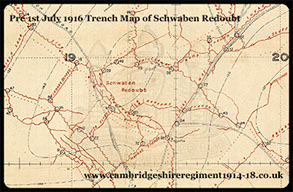
Who Were
The Cambs
The Cambs
at War
1/1st Btn 1914-1919
1914 - 1/1st Overview
1915 - 1/1st Overview
1915 - St Eloi
1915 - Fosse Wood
1916 - 1/1st Overview
1916 - The Schwaben
1916 - St Pierre Divion
1917 - 1/1st Overview
1917 - St Julien
Insignia, Medals & Books
Remembering The Cambs
Biographies
About Us &
This Site
The Cambridgeshires and the Schwaben Redoubt - October 14th & 15th 1916
Part 1 - Background and History
For the men of the Cambridgeshire Regiment October 14th, 1916 stands out as one of the key dates of the Regiment’s war. Up until this date some vocal people around the county of Cambridgeshire still held a rather unfavorable view of their local Territorial Force Regiment. The old prejudices and persistent sneers of “Saturday night soldiers” had proven hard to shake. These unjust and inaccurate views persisted even though the 1/1st Battalion had served on the Western Front since February 1915 and had repeatedly proved to be an efficient and reliable front line unit. However, despite the long months of attritional trench warfare and involvement in numerous raids and small-scale actions, the Battalion had not directly participated in any of the big newspaper headline grabbing over the top attacks. Since July 1st and the start of the much anticipated Somme offensive the newspapers had been full of reports of the attacks and stories of unimaginable gallantry in the face of huge casualties. The absence of the Cambridgeshires from these headlines was all to change one mid October afternoon on the shell-cratered earthworks of a German fortification.
Much has been written about the German strongpoint officially known to the British soldiers as the Schwaben Redoubt and, unofficially, by many of the men who fought and died on its gentle slope as the Devil’s Dwelling Place. The Schwaben sat above the Ancre river valley, to the north of the village of Thiepval. It formed part of an interlocking triangle of defensive strongpoints that controlled the local landscape. From their well constructed position in the Redoubt the Germans could unleash devastating machine gun fire for thousands of yards to the south and across the valley to the west. It was widely recognised that this fortification was the key to the whole surrounding stretch of the Somme front line.
On July 1st the men of the 36th (Ulster) Division were tasked with attacking and capturing the German positions to the east of the Ancre, including the Schwaben. Their now legendary attack on that day was initially hugely successful and the Ulstermen swarmed over the Redoubt. However as the day went on, and the attacks by the divisions on either flank failed, the Ulstermen were slowly cut off and surrounded. Despite a valiant and bitterly fought stand the Schwaben was completely back in German hand by the following morning.
This now blood-soaked ground, still littered with the bodies of friend and foe, became a thorn in the side for General Haig and the repeated British attacks failed in the face of the determined German defenders. Any successes were met by swift and ferocious German counter attacks and the battered trenches were soon recaptured and back in German hands.
As the great Somme offensive rolled on into late summer some gains were being made and on September 26th the 18th (Eastern) Division successfully took the fortified village of Thiepval and also gained a key foothold in the southern face of the Schwaben. For the first time a section of the Redoubt fell and had been successfully held. Further British attacks met with mixed, but always costly, results. These attacks did manage to consolidate the foothold and the southern sections continued to fall. By October 11th the southern face of the Schwaben was firmly in British hands but the northern section still stood defiantly against all attacks.
The Cambridgeshires had first come into contact with the Schwaben in early September when, from their positions on the opposite side of the Ancre valley, they had front row seats to several of the bloody failed assaults on the earthworks. The Schwaben was well known to all soldiers in that area of the Somme, both British and German, and all knew of the rapidly mounting cost in lives for both the attackers and defenders. For the German regiments tasked with holding this section of the Somme the importance of the Schwaben to the defence of the whole area was fully recognised and these regiments suffered large amounts of casualties in order to hang onto it.
In early October the Cambs, along with the rest of their division, moved across from the western side of the Ancre to the positions in front of the looming Redoubt. The Division’s 117th Brigade was quickly ordered to launch what turned out to be a badly planned attack on the northern face, resulting in further heavy casualties. It was in the days following this attack that the Commanding officer of the Cambridgeshires, Lt-Col Ted Riddell, was informed it was their turn to lead the next assault on the shattered but unyielding fortification. Luckily for the Cambs Riddell, expecting just such an order, had already began devising his plan and he had learnt from the costly failures of the previous months.
Part 2 - Riddell's Plan
Back to the top of the page.
The Cambridgeshires & the Schwaben Redoubt
Part 1 - Background & History of the Redoubt
Part 2 - Riddell's Plan
Part 3 - Misfortune & Postponement
Part 4 - The Assault
Part 5 - Strong Points & Riddell Trench
Part 6 - Gallant Deeds
Part 7 - Counter-Attacks and Relief

Trench map of the Schwaben area (click above image to enlarge).

This site went live on the 14th February 2015 to mark 100 years since the 1/1st Cambs went off to war.
WE WILL REMEMBER THEM
Email us: cambsregt@gmail.com
Copyright 2015, 2016, 2017, 2018, 2019 by Felix Jackson. The information and images on this site should not be reproduced without prior permission.